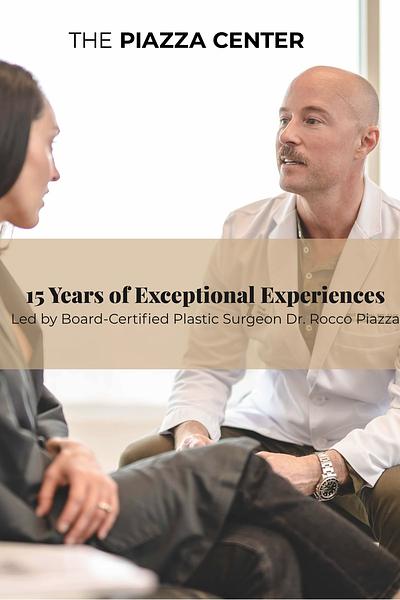
Exosome Skincare? The Science Behind the Next Generation of Regenerative Healing
If you’ve heard the buzz about exosome skincare, you’re not alone. This next frontier in regenerative aesthetics is transforming how the skin heals, repairs, and rejuvenates. But with all the hype, there’s also confusion — especially about what exosomes really are and how they compare to stem cells or PRP (platelet-rich plasma).
At The Piazza Center, we use exosomes in both post-procedure recovery and advanced daily care because the science supports it — not the marketing. Here’s what you need to know.
What Are Exosomes? Exosomes Are the Message — Not the Cell
“Unlike cells, exosomes are extracellular vesicles. They don’t contain a nucleus — and that’s a feature, not a flaw.”
— Dr. Rocco Piazza
Exosomes are tiny lipid-bound vesicles released by cells to communicate with other cells. Think of them as biological messengers — carrying molecular “instructions” in the form of mRNA, microRNA, and proteins that guide how surrounding tissue behaves.
They don’t divide or replicate. Instead, they deliver precise repair and regeneration signals that tell the skin how to remodel itself — safely, intelligently, and effectively.
What’s inside an exosome:
-
mRNA & microRNA: Deliver repair instructions for collagen, elastin, and DNA renewal
-
Proteins: Support structural rebuilding and hydration pathways
-
Lipids: Strengthen the skin barrier and enhance communication
-
Cytokines: Calm inflammation and promote healing

Types of Exosomes Used in Skincare Products
Platelet vs. Adipose Exosomes — What’s the Difference?
At The Piazza Center, we integrate two advanced exosome technologies: Plated Intense Serum and Exoceuticals HA Serum (powered by EXO3). Each is designed for a different stage of recovery and skin optimization.
| Feature | Plated Intense Serum | Exoceuticals HA Serum |
|---|---|---|
| Source | Platelet-derived exosomes | Adipose-derived mesenchymal exosomes |
| Primary Role | Calms inflammation and supports early healing | Stimulates collagen I & II for long-term regeneration |
| Ideal Use | Immediately post-procedure | Once the skin is healed and ready for remodeling |
| Key Benefit | Hydration, redness reduction, barrier repair | Smoother texture, improved elasticity, refined tone |
| Hero Mechanism | Growth factor-rich platelet exosomes | Engineered EXO3 cargo optimized for skin biology |
“Platelet-based exosomes, like Plated, are perfect for immediate recovery.
Adipose-derived exosomes, like Exoceuticals and their EXO3 technology, take over during the remodeling phase — improving skin quality and long-term results.”
— Dr. Rocco Piazza
- Bosslett M. “Unlocking Skin’s Regenerative Power: Robin Smith, MD, MBA on the Science of Exosomes.” Dermatology Times. July 2025. This interview with Dr. Robin Smith (co-founder of Exoceuticals) describes how engineered adipose-derived exosomes are used to deliver regenerative signals such as collagen, elastin, and hyaluronic acid. Dermatology Times+1

Why Collagen Type Matters
Collagen is the architectural framework of your skin and there are various exosome skincare options based on the results. But not all collagen types perform the same role. Understanding which type your product stimulates is key to optimizing both healing and longevity.
| Collagen Type | Role in Skin Health |
|---|---|
| Type I | Strength and firmness — the foundation of youthful skin |
| Type II | Smooth texture and flexibility — key for healthy remodeling |
| Type III | Early repair scaffolding — important after injury but excessive amounts can create thick or raised scars |
At The Piazza Center, we focus on balancing Type I and II collagen stimulation through our use of adipose-derived exosomes (EXO3), helping patients achieve smoother, stronger, more even-toned skin after procedures.

Science Meets Skincare
The difference between exosome sources lies in their cargo — the mRNA and microRNA inside that instruct tissue on what to do.
Adipose stromal cells (used in EXO3) share the same embryologic origin as skin, giving them a genetic “language” perfectly suited for repair and regeneration. These exosomes are engineered to enhance signals for collagen, elastin, and DNA repair, creating visible results over time.
By contrast, platelet-derived exosomes (found in Plated Intense Serum) are ideal for calming the skin immediately post-procedure — reducing redness, improving comfort, and hydrating deeply.
Together, they form a seamless recovery and rejuvenation strategy:
-
Plated Intense Serum: Your skin’s first responder.
-
Exoceuticals HA Serum: Your skin’s architect.
Why Packaging Integrity Matters
Exoceuticals products are housed in Myron violet bio-photonic glass — a premium, light-filtering material that protects exosome cargo from UV degradation without refrigeration or preservatives.
This technology preserves the integrity of the exosomes naturally, aligning with The Piazza Center’s commitment to clean, clinically verified formulations that patients can trust.
Patient Takeaways
-
Exosomes are messengers, not cells.
-
Platelet exosomes calm and protect the skin immediately after treatment.
-
Adipose exosomes remodel collagen and enhance long-term regeneration.
-
Collagen I + II stimulation leads to smoother, more resilient skin.
-
Smart, light-protective packaging preserves potency without preservatives.
“We’re not just closing wounds — we’re improving how the skin remodels.”
— Dr. Rocco Piazza
- Schaffer S, et al. “A Scoping Review of Exosome Delivery Applications in Regenerative Medicine.” PMC12020662. (2025) A broader academic review indicating how extracellular vesicles (exosomes) show promise in wound healing, skin regeneration, and aesthetic applications. PMC
Shop the Regenerative Skincare Duo
Shop Plated Intense Serum →
Ideal for post-laser, microneedling, or any procedure that leaves the skin vulnerable or inflamed.
Shop Exoceuticals HA Serum →
Perfect for daily use or the remodeling phase following recovery — strengthens collagen and supports smoother, more even-toned skin.

Choosing the Right Exosome Skin Care Products and Exoceuticals
What to Look For in Products
- Clear sourcing: platelet-derived or mesenchymal exosome origin
- Transparency on exosome concentration and purity
- Stability: in formulations optimized to preserve exosome cargo integrity
- Additional active ingredients like collagen boosters or antioxidants
- Clinical studies supporting efficacy where available
Conclusion: Embracing the Power of Exosome Skincare
Exosome skincare offers an advanced, science-backed way to support skin regeneration, boost collagen, and combat inflammation without the risks associated with whole-cell therapies due to the absence of an exosome nucleus. Whether choosing platelet exosomes for their rapid repair potency or mesenchymal exosomes for broad rejuvenation, understanding the difference helps you select the right exosome skin care products. Incorporating these innovative exoceuticals into your routine can transform skin health, texture, and resilience. Ready to explore exosome skincare? Dive deeper into trusted products and expert-recommended treatments to unlock your skin’s regenerative potential today.
Appendix: Key Clinical Studies & Expert Sources on Exosomes
-
Kaufman-Janette J, Cazzaniga A, Jacobson A, et al. “Effect of Topical Platelet Extract Daily Serum as a Cosmetic Product to Reduce Facial Redness.” PMC 10617900. This pilot study evaluated six subjects using a serum containing human platelet extract (HPE) with exosome technology and found statistically significant improvements in redness and skin condition after six weeks. PMC
-
Wyles S. “Efficacy and Tolerability of Topical Platelet Exosomes for Skin Rejuvenation: Six-Week Results.” Aesthetic Surgery Journal. 2022;42:1185. This study demonstrated that a platelet-derived exosome product induced measurable improvements in skin health, redness, wrinkles, and pigmentation over 4–6 weeks. OUP Academic+1
-
Bosslett M. “Unlocking Skin’s Regenerative Power: Robin Smith, MD, MBA on the Science of Exosomes.” Dermatology Times. July 2025. This interview with Dr. Robin Smith (co-founder of Exoceuticals) describes how engineered adipose-derived exosomes are used to deliver regenerative signals such as collagen, elastin, and hyaluronic acid. Dermatology Times+1
-
Mayo Clinic. “Tapping into the Potential of Platelet-Derived Exosomes in Aesthetics.” May 13, 2025. This article reviews how platelet-derived exosomes serve as “messengers” in regeneration, supporting collagen production and improving skin quality following procedures — and clarifies that exosomes are cell-free (no nucleus) and thus avoid risks of replication. Mayo Clinic
-
Schaffer S, et al. “A Scoping Review of Exosome Delivery Applications in Regenerative Medicine.” PMC12020662. (2025) A broader academic review indicating how extracellular vesicles (exosomes) show promise in wound healing, skin regeneration, and aesthetic applications. PMC



